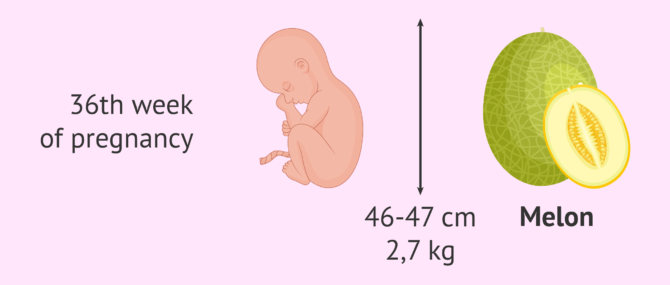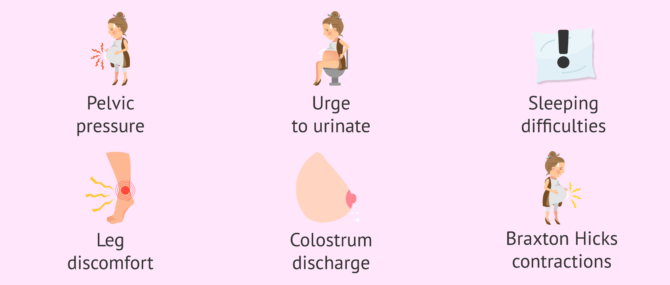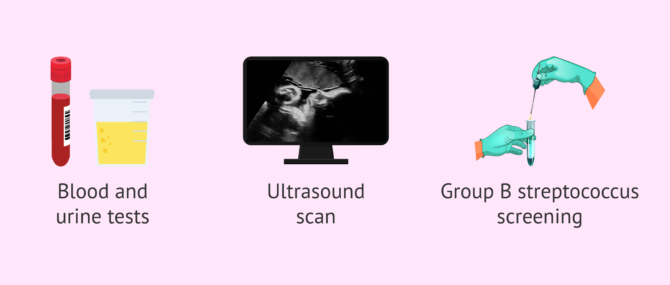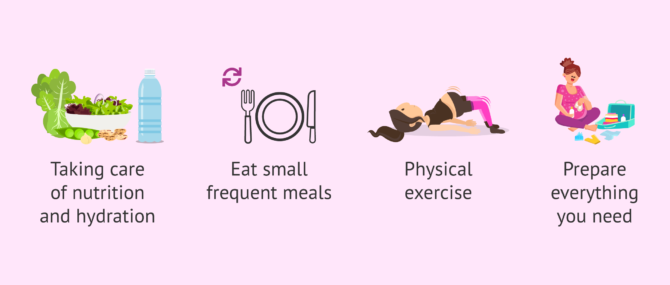The 36th week of pregnancy corresponds to the third trimester (9 months of gestation) and is therefore part of the final stretch of pregnancy. Therefore, due to the size that the mother's womb has already reached at this point of gestation, it is common for the pregnant woman to notice certain discomforts and symptoms.
On the other hand, during this week it is possible that the woman may be screened for group B streptococcus. This is a very simple test, which only requires taking a vagino-rectal sample from the woman, but it reduces the risk of the baby suffering a very serious infection after delivery.
Provided below is an index with the 8 points we are going to expand on in this article.
- 1.
- 2.
- 3.
- 4.
- 5.
- 5.1.
- 5.2.
- 5.3.
- 6.
- 7.
- 8.
How is the baby doing in the 36th week of pregnancy?
At 36 weeks gestation, the baby is already around 46-47 cm long, with a weight that can be around 2.7 kg. The pregnant woman may notice during this week that the fetal movements are different and this happens for a simple reason: there is little space left in the uterus due to the size the baby has already acquired.
However, the baby continues to move despite the reduced space, so the woman must continue to feel the baby and control the movements in the manner indicated by the specialist. In the event that a decrease in activity is detected or movements are no longer perceived, the pregnant woman should go to the gynecologist so that he/she can check that everything is all right.
The baby's skin is now smoother and pinker because it is accumulating fat, which will help it maintain its temperature after birth, and because the lanugo (a fine hair covering the skin) is disappearing.
In addition, the baby is usually already in the cephalic position, i.e., with the baby's head down towards the mother's pelvis. If this is not the case and the baby is breech, at this point in gestation it is quite uncommon for the baby to turn over due to lack of space.
For this reason, specialists may propose to perform an external cephalic version (ECV). This is an obstetrical maneuver to try to turn the baby around, otherwise breech babies are usually delivered by cesarean section.
If the baby is born in the 36th week of pregnancy, it is still premature. However, there is a good chance that she will have a good adaptation to life outside the womb.
Maternal symptoms in week 36
By the 36th week of pregnancy, the baby's head may fit into the mother's pelvis. When this happens, the pregnant woman's belly will feel lower and, because of this, she may have less difficulty breathing and discomfort such as heartburn may be reduced.
Instead, the wedging of the baby will increase the pressure on the pelvis and the woman may have more difficulty moving and walking. In addition, the pregnant woman will feel the urge to urinate more frequently.
However, other possible symptoms or discomforts of the 36th week of pregnancy are:
- Back pain.
- Heaviness, tiredness.
- Vaginal discomfort and increased vaginal discharge.
- Sleeping difficulties.
- Fluid retention, swelling and discomfort in the legs, such as cramps and varicose veins.
- Carpal tunnel syndrome.
- Constipation and hemorrhoids.
- Stretch marks.
- Possible secretion of colostrum.
In addition, in this final stretch of pregnancy the woman may notice contractions. Most commonly these are Braxton Hicks contractions, which feel like the belly is getting hard, but irregularly. In addition, these contractions do not increase in frequency or intensity, unlike labor contractions, which do. If labor contractions appear, the pregnant woman should see a specialist as soon as possible.
Tests and medical control at 36 weeks of gestation
In general, when the pregnant woman visits the specialist, weight and blood pressure will be checked and the abdomen will be palpated (among other examinations).
In addition, a third trimester check-up may be performed in the 36th week of pregnancy. It consists of:
- Blood and urine tests, to check for anemia, to perform coagulation tests for possible anesthesia during labor and to rule out urinary tract infections or the presence of protein in the urine (proteinuria).
- Ultrasound, in which the position and development of the baby will be evaluated, as well as the state of the placenta and amniotic fluid.
In addition, between the 35th and 37th week, the screening test for group B streptococcus is also performed. This is a bacterium that does not produce symptoms in healthy adults, but can be transmitted to the baby at the time of delivery, causing serious problems. Therefore, it is important to detect which women are carriers of group B streptococcus, in order to try to prevent the baby from being infected.
You can learn more about this test in the following article: What is the Group B Streptococcus test in pregnancy?
Recommendations in week 36
It is very important for a woman to monitor her nutrition and hydration throughout her pregnancy, including during the 36th week, so that she and her baby do not lack any necessary nutrients. However, the most advisable way to reduce acidity and reflux is to eat several times a day, but in small quantities. Thus, digestion will be lighter.
Similarly, it is important to exercise, adapted to pregnancy and as long as it has not been contraindicated by a specialist.
Finally, the woman can start this week to prepare the baby's clothes and everything necessary for the baby's arrival, as well as the hospital bag.
FAQs from users
How many months is 36 weeks of pregnancy?
If we convert weeks into months, the 36th week of gestation would be about 9 months of pregnancy. Therefore, the pregnant woman is in the third trimester of gestation and in the final stretch of pregnancy.
Is it possible to expel the mucus plug in week 36?
Yes, it would be possible to expel the mucus plug in the 36th week of pregnancy. The mucus plug is a secretion located in the cervix that serves to prevent the passage of microorganisms from the vagina to the uterus during pregnancy.
The expulsion of the mucus plug occurs when the time of delivery approaches, but it does not mean that delivery is imminent. When the mucus plug is expelled, it can be seen in the underwear as a mucus-like discharge that may have a trickle of blood in it.
Is shortness of breath in the 36th week of pregnancy normal?
The sensation of fatigue, shortness of breath and, in general, a certain difficulty in breathing is common in late pregnancy, due to the size of the pregnant woman's belly.
However, in the 36th week of gestation it is possible for the baby's head to fit into the mother's pelvis. If this happens, the belly will drop and the woman may feel an improvement in her breathing.
Suggested for you
If you are 36 weeks pregnant, you may also want to know what will happen in the next week. To do so, you can access the following article: 37 Weeks Pregnant.
If you want to know more about seminal quality, we recommend you to read this article: Prenatal pregnancy control: tests, laboratory tests and ultrasound scans.
We make a great effort to provide you with the highest quality information.
🙏 Please share this article if you liked it. 💜💜 You help us continue!
References
Akolekar R, Panaitescu AM, Ciobanu A, Syngelaki A, Nicolaides KH. Two-stage approach for prediction of small-for-gestational-age neonate and adverse perinatal outcome by routine ultrasound examination at 35-37 weeks' gestation. Ultrasound Obstet Gynecol. 2019 Oct;54(4):484-491. doi: 10.1002/uog.20391. Epub 2019 Aug 27. PMID: 31271475. (View)
Ciobanu A, Anthoulakis C, Syngelaki A, Akolekar R, Nicolaides KH. Prediction of small-for-gestational-age neonates at 35-37 weeks' gestation: contribution of maternal factors and growth velocity between 32 and 36 weeks. Ultrasound Obstet Gynecol. 2019 May;53(5):630-637. doi: 10.1002/uog.20267. Epub 2019 Apr 8. PMID: 30912210. (View)
De Castro H, Ciobanu A, Formuso C, Akolekar R, Nicolaides KH. Value of routine ultrasound examination at 35-37 weeks' gestation in diagnosis of non-cephalic presentation. Ultrasound Obstet Gynecol. 2020 Feb;55(2):248-256. doi: 10.1002/uog.21902. PMID: 31671470. (View)
Escobar GJ, Clark RH, Greene JD. Short-term outcomes of infants born at 35 and 36 weeks gestation: we need to ask more questions. Semin Perinatol. 2006 Feb;30(1):28-33. doi: 10.1053/j.semperi.2006.01.005. PMID: 16549211. (View)
Ficara A, Syngelaki A, Hammami A, Akolekar R, Nicolaides KH. Value of routine ultrasound examination at 35-37 weeks' gestation in diagnosis of fetal abnormalities. Ultrasound Obstet Gynecol. 2020 Jan;55(1):75-80. doi: 10.1002/uog.20857. Epub 2019 Oct 8. PMID: 31595569. (View)
Kelly MM, Tobias J. Recommendations to optimize life-long health and wellbeing for people born preterm. Early Hum Dev. 2021 Nov;162:105458. doi: 10.1016/j.earlhumdev.2021.105458. Epub 2021 Sep 1. PMID: 34493417. (View)
Kwok M, Angioni V. Additional single third trimester ultrasound scan in detection of large for gestational age fetuses. Curr Opin Obstet Gynecol. 2022 Oct 1;34(5):275-278. doi: 10.1097/GCO.0000000000000813. Epub 2022 Aug 24. PMID: 36036474. (View)
FAQs from users: 'How many months is 36 weeks of pregnancy?', 'Is it possible to expel the mucus plug in week 36?' and 'Is shortness of breath in the 36th week of pregnancy normal?'.




